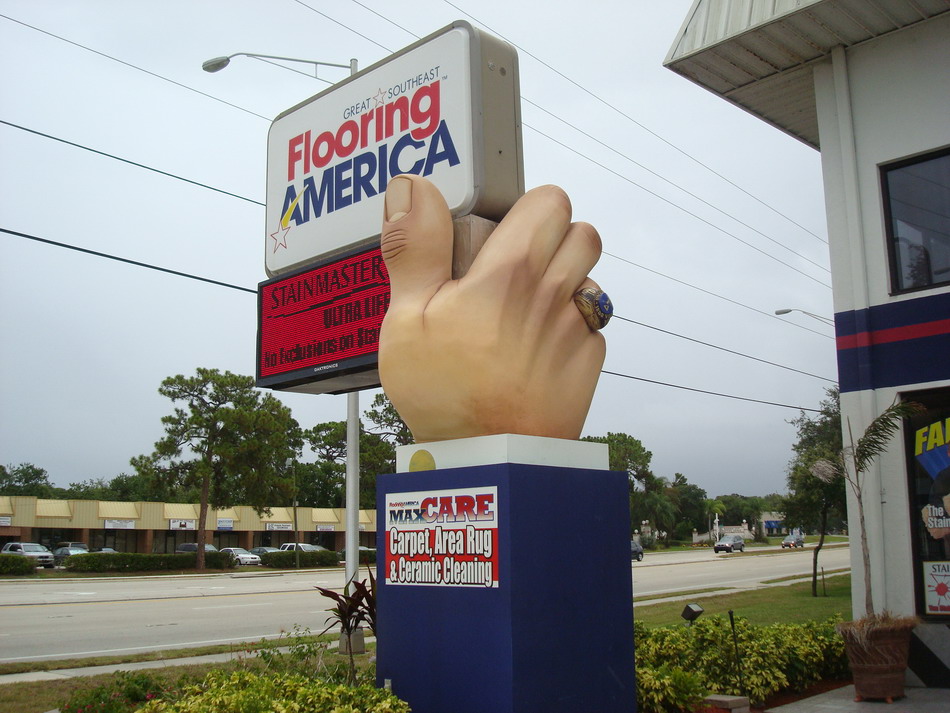Design
Let’s Give Him a Hand
Published
14 years agoon

Dale Salamacha is co-owner of Longwood, FL-based Media 1, a sign-fabrication shop, and Wrap This, which specializes in vehicle wraps. His shops have won several awards in ST s Vehicle Graphics and Sign Design Contests.
Flooring America’s owner/operator, Nelson Green, initially contacted our company last year, it was because he wanted a vehicle wrap on his brand new Smart Car. Little did he know that he would receive an even bigger hand from our crew!
He told us the roadside pylon sign at his 16,000-sq.-ft. showroom and warehouse (located on U.S. Hwy 1 in Melbourne, FL, a major thoroughfare) lacked the “punch” Green wanted. After touring our facility, he realized our shop could help change all that.
Mr. Green asked if we could manufacture a giant hand sculpture that would look like it was holding up his sign. After reviewing drawings he already had designed, we assured him that we could and, after we agreed on a price, we began the process.
First, we surveyed the existing sign. Our VP, Rick Ream, and salesman, Gene Knight, traveled 45 minutes to the client’s location near the beach. Once on site, they took measurements of the sign, pole cover, and the interior framework were made. Since this was a custom application and the sign already existed, very accurate measurements were essential to fitting the new hand within the framework.
Armed with photos and survey measurements, the crew began to devise a plan. We fabricated a 2-in.-thick, aluminum-angle framework that’s identical in dimension to the existing, steel-pylon cage. This allowed a good reference point. We created the cage only to stage fabrication; it would have no role in the final install. Once the cage was built, fabricators mounted it to rolling dollies, which allowed us to move the project more easily around the shop.
AdvertisementTo construct the sculpture, we used two, 4 x 8 x 2-ft. and one, 4 x 8 x 1-ft. block of expanded-polystyrene foam (EPS). Fabricators screwed the blocks to the aluminum framework and “glued” them together with Dow Chemical’s EnerFoam spray sealant. At this point, it was time for Media 1’s lead painter, Rene Mendez, to begin his magic.
He began scrawling a crude sketch directly on the foam, but soon realized this was an unnecessary step. Instead of following a pattern, Rene carved by feel. To carve out the basic shape of the hand, Rene used several tools. He began roughly shaping the sculpture with a typical wood hand saw. This made quick work of most of the foam, and a thumb began to form.
Next, brandishing a Bondo file and some fine-toothed saws, Rene finished the rough-in of the back of the hand and thumb. Moving around to the knuckles, he started working again with the wood saw to remove the bulk of material needed to create some knuckle detail and finger delineation. After Rene switched back to the finer cutting tools, fingernails and knuckle creases began to take shape.
Once he was happy with the hand’s overall form and shape, Rene began the tedious task of roughly sanding the entire surface with 3M 80-grit sandpaper. Using this, he rounded out areas, smoothed over saw marks and added ample detail to the fingertips and knuckles.
Now, we began truly customizing the project. Not only did Mr. Green want a big hand in holding up his pylon sign, but he also wanted an oversized rendering of his college ring featured! Using scrap chucks of EPS foam, Rene carved the ring in two separate pieces. The first piece attached directly to the finger and the second piece, the actual gem, was affixed atop the ring. After carving the desired shape, Media 1 pin-mounted and glued it onto the appropriate finger using EnerFoam.
After this process was complete and everyone was happy with the detail, Rene made one final pass around the entire surface with 3M 180 grit sandpaper. Although not as smooth as glass, this final step rendered the very porous, white EPS foam smooth enough for our next step.
AdvertisementTo make EPS foam suitable for exterior installations, Media 1 uses the Volatile Free Inc.’s VFI Qwik Spray System. Media 1’s Damon Coppola sprayed on the first of four layers of rigid polyurethane hard coat.
This sprayable encapsulate is a 100% solid, two-component, aromatic polyurethane coating that’s designed to provide an impact-resistant shell for such substrates as EPS foam, high-density urethane and wood. It’s also environmentally safe and contains no VOC’s.
This Qwik Spray System contains a dual-cartridge spray applicator, air-atomizing tip and spray nozzle. Slipping the dual cartridges into the spray applicator takes mere seconds, and mixing the two components occurs via a static mixer tube that’s attached to the end of the units. Because compressed-air pressure is low, a regulator assists with the system’s air flow and spray pattern. Damon and Rene sprayed on a total of eight cartridges to achieve the hard, durable, smooth finish desired. The coating was dry to the touch in under an hour.
We allowed the hand to sit overnight to fully cure. When we arrived the next day, we lightly scuffed the dry material to assure topcoat adhesion.
Now, the fun begins. With perfect shape “in hand” and a nice, smooth hardcoat sealing the project throughout, we added some color. Utilizing our Mathews urethane paint system, Rene mixed his blend of colors and laid down two solid coats of satin-finish beige in our cross-draft paint booth.
After applying the basecoat, Rene pulled out his Paasche VL airbrush and loaded it with a darker shade of Matthews brown and began adding levels of highlights to the fingers, fingernails and the back of the hand. Apply lighter shades that simulate nail cuticles and other fine details really added life.
AdvertisementAfter Rene was satisfied with the hand’s skin tones and finish, he began mixing colors and airbrushing details from his college ring. Suddenly, the University of Florida ring from the class of 1970, which featured a detailed “Gator” with gaping jaws, popped against the sculpture’s skin tones. With the final piece installed, the hand was ready for installation the next day.
Loading the hand into the bed of a pickup truck, Media 1’s lead installers, Ronnie Osgood and Steve Pass headed to Melbourne. Imagine the comments from cars passing by!
Once onsite, the installers utilized the client’s forklift to lift the hand into place on the pylon structure. Although a forklift provided the easiest installation route, the entire hand sculpture, which weighed only 150 lbs. thanks to EPS’s light weight, could be easily picked up by two men. Although this may appear to require a lengthy install, it actually only required a couple of hours to place the hand into position and fasten it to the pylon framework.
Using a small “wrist” piece of the hand as a separate appliqué allowed the installers to fasten the sculpture to the steel framework from the inside of the structure. Drilling through the steel angle, we threaded long screws into the interior “flesh” of the hand. The bottom base of the hand resting firmly on the pole cover’s base “sleeve.”
After the screws were installed, the installers poured bursts of EnerFoam foam sealant onto the hand and steel angle to form a solid bond between the two materials. The separate wrist piece was then set into place and bonded to the main part of the hand in the same fashion. We were done!
The client is ecstatic over his new conversation piece (he’s especially pleased with the ring), and has reported a definite increase in traffic and positive feedback.
Media 1 was proud to put its many hands to work to create this sculpture that transforms a typical pylon structure into a bona fide head-turner!
SPONSORED VIDEO
Introducing the Sign Industry Podcast
The Sign Industry Podcast is a platform for every sign person out there — from the old-timers who bent neon and hand-lettered boats to those venturing into new technologies — we want to get their stories out for everyone to hear. Come join us and listen to stories, learn tricks or techniques, and get insights of what’s to come. We are the world’s second oldest profession. The folks who started the world’s oldest profession needed a sign.
You may like
Advertisement
Subscribe

Magazine
Get the most important news
and business ideas from Signsofthetimes Magazine.
Advertisement
Most Popular
-

 Tip Sheet4 days ago
Tip Sheet4 days agoAlways Brand Yourself and Wear Fewer Hats — Two of April’s Sign Tips
-

 Business Management2 weeks ago
Business Management2 weeks agoWhen Should Sign Companies Hire Salespeople or Fire Customers?
-

 Women in Signs2 weeks ago
Women in Signs2 weeks ago2024 Women in Signs Award Winners Excel in Diverse Roles
-

 Real Deal5 days ago
Real Deal5 days agoA Woman Sign Company Owner Confronts a Sexist Wholesaler
-

 Benchmarks1 day ago
Benchmarks1 day ago6 Sports Venue Signs Deserving a Standing Ovation
-

 Editor's Note1 week ago
Editor's Note1 week agoWhy We Still Need the Women in Signs Award
-

 Line Time2 weeks ago
Line Time2 weeks agoOne Less Thing to Do for Sign Customers
-

 Product Buying + Technology1 week ago
Product Buying + Technology1 week agoADA Signs and More Uses for Engraving Machines










